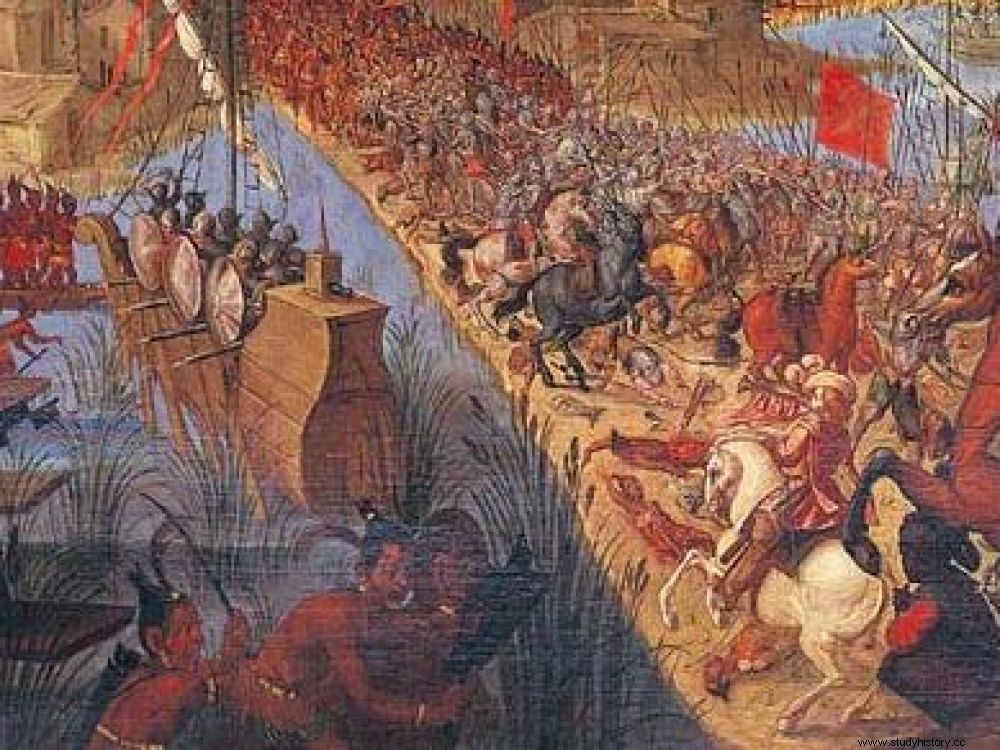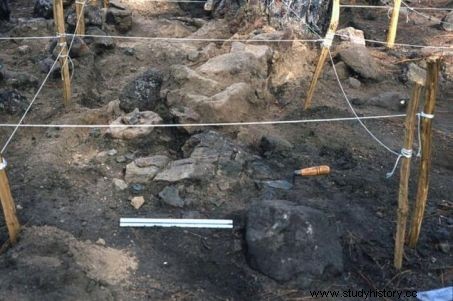In the 17th century, during the colonial period that followed the conquest of Mexico, the Spaniards had to rely on the metallurgical knowledge of local communities to melt their armament and maintain their arsenal in good condition.

Conquest of Mexico by the Spaniards (1519-1521).
Crossing little-exploited ethnographic sources with recent archaeological discoveries... and it's a whole section of the history of the conquest of Mexico that suddenly appears in a new light. This is the unpublished work carried out by Dorothy Hosler, professor of archeology and ancient technology at the Massachusetts Institute of Technology (MIT) in Cambridge (United States), in the coastal state of Guerrero, in the south of present-day Mexico. The young woman and her team spent four years studying imposing deposits of copper slag accumulated in old smelters in El Manchon, in the Sierra Madre del Sur.
This allowed them to establish that the first Spanish occupants, who arrived in this isolated region of New Spain in the 17th century, had to rely on the knowledge of the native metallurgists to be able to produce the copper necessary for the manufacture of their weapons. A confirmation of what only the historical archives documented until then. The study, published in the journal Latin American Antiquity , recalls that the Conquistadors had no knowledge of copper smelting. In the 16th century, no copper mine was in fact exploited in Spain and all the transformed material used in the Iberian Peninsula came from Central Europe and Scandinavia. "The Spaniards understood that the only way they could smelt copper was to work with the natives who were already doing it “, explains Dorothy Holster, joined by Sciences et Avenir.
A copper ore mined for centuries
Local societies had been exploiting this mineral for centuries, both for its color, close to the gold to which it was often combined, and for the production of ritual objects, including cowbells and bells (musical instruments) collected in number in the graves (read box ). In New Spain - as the newly conquered Mexico was then called - the Conquistadors were then able to obtain in quantity this metal which they needed so much, especially for their artillery, as indicated by the large quantities of copper slag found.
"We had a theoretical idea of it thanks to the d documents history of the colonial period that showed how the Spaniards present in certain outposts had to negotiate with the local populations to acquire this copper, in exchange for tax exemptions and other economic privileges", explains Johan Garcia Zaidua, historian from the University of Porto (Portugal), co-signatory of the article.
Crossing little-exploited ethnographic sources with recent archaeological discoveries... and it's a whole section of the history of the conquest of Mexico that suddenly appears in a new light. This is the unpublished work carried out by Dorothy Hosler, professor of archeology and ancient technology at the Massachusetts Institute of Technology (MIT) in Cambridge (United States), in the coastal state of Guerrero, in the south of present-day Mexico. The young woman and her team spent four years studying imposing deposits of copper slag accumulated in old smelters in El Manchon, in the Sierra Madre del Sur.
This allowed them to establish that the first Spanish occupants, who arrived in this isolated region of New Spain in the 17th century, had to rely on the knowledge of the native metallurgists to be able to produce the copper necessary for the manufacture of their weapons. A confirmation of what only the historical archives documented until then. The study, published in the journal Latin American Antiquity , recalls that the Conquistadors had no knowledge of copper smelting. At 16 th century, no copper mine was in fact exploited in Spain and all the processed material used in the Iberian Peninsula came from Central Europe and Scandinavia. "The Spaniards understood that the only way they could smelt copper was to work with the natives who were already doing it “, explains Dorothy Holster, joined by Sciences et Avenir.
A copper ore mined for centuries
Local societies had been exploiting this mineral for centuries, both for its color, close to the gold to which it was often combined, and for the production of ritual objects, including cowbells and bells (musical instruments) collected in number in the graves (read box ). In New Spain - as the newly conquered Mexico was then called - the Conquistadors were then able to obtain in quantity this metal which they needed so much, especially for their artillery, as indicated by the large quantities of copper slag found.
"We had a theoretical idea of it thanks to the d documents history of the colonial period that showed how the Spaniards present in certain outposts had to negotiate with the local populations to acquire this copper, in exchange for tax exemptions and other economic privileges", explains Johan Garcia Zaidua, historian from the University of Porto (Portugal), co-signatory of the article. From 1521, Hernan Cortès himself – who seized the Aztec empire on behalf of the King of Spain Charles V – had expressed this availability present in New Spain to cast bronze artillery pieces after successful tests carried out on site. This local know-how thus enabled the Spaniards present in remote regions to overcome the shortcomings of their conquering organization in order to reconstitute and maintain their arsenal.

Remains of one of the Mesoamerican smelting furnaces used by settlers at El Manchon (Guerrero) during its excavation. © Dorothy Hosler / MIT
At El Manchon, archaeologists have thus found remains reflecting a mixture of European and local knowledge. Dorothy Hosler and her colleagues identified the remains of a closed hybrid oven, a model hitherto unknown, powered by a hand-operated bellows of European origin. Through these technological improvements, the high air supply made it possible to reach higher melting temperatures and thus increase production volumes. In fact, the intensive production activity of El Manchon would have started around 1630 and ended around 1825. "We can also imagine the overwhelming consequences for these populations, when these divine materials which represented and evoked the supernatural , they saw the emergence of artillery elements or weapons used to oppress" , concludes Dorothy Holster. Unfortunately, while this research promised to be most fruitful, the archaeologists had to interrupt their work due to social unrest linked to the presence in the region of a drug cartel.
A Brief History of Mesoamerican Pre-Hispanic Metallurgy
Unlike China, the Andes, Colombia or the Near East, in Mesoamerica - that geographic area stretching from Mexico to Costa Rica including Belize, Guatemala, Honduras, El Salvador and Nicaragua - the use of the metal would not have appeared until around 700. Before 1100, most objects were made from copper, then copper-tin (Cu-Sn), copper-arsenic (Cu-As), copper-silver ( Cu-Ag) and gold-copper (Au-Cu) have become more common. The peoples of western Mexico were interested in metal for its color and sound. Objects made in this way were considered sacred, living and powerful. Strangely, iron was never used by pre-Columbian goldsmiths, who perhaps never managed to reach the 1536°C necessary for its fusion.
